Produce explained: 13 types of apples to have in your pantry
You know that one friend whom everyone turns to for almost anything under the sun? When it comes to fruits, apples are that friend. It’s hard to top its popularity and ubiquity—it’s even the name of a brand, no prizes for guessing. Mostly sweet, delicious, and versatile, these candies of the earth are a busy mainstay in the kitchen. They are a perfect fuss-free snack, preferred cooking ingredient and the star in dishes. Apple crumble, apple cider, pulled pork with apple slaw—you get the point.
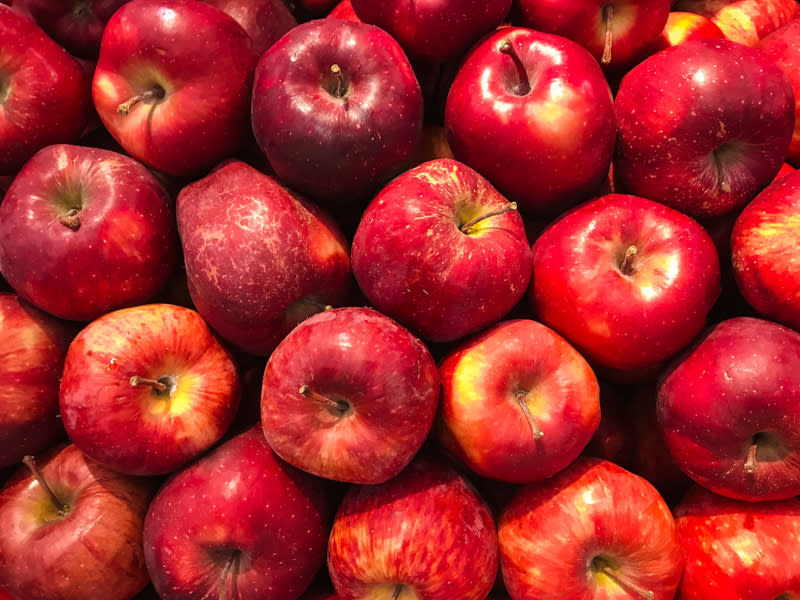
Yet not all apples are equal in every criteria—differing in sweetness and acidity, texture, and colour. Cultivated naturally from seeds or from breeding programmes, many varieties have been produced by crossing types, thus it’s no wonder that there are over a whopping 7500 cultivars of apples. So, in this part of our Produce Explained series, we talk about these 13 more common types of apples that’ll come in handy in the kitchen.
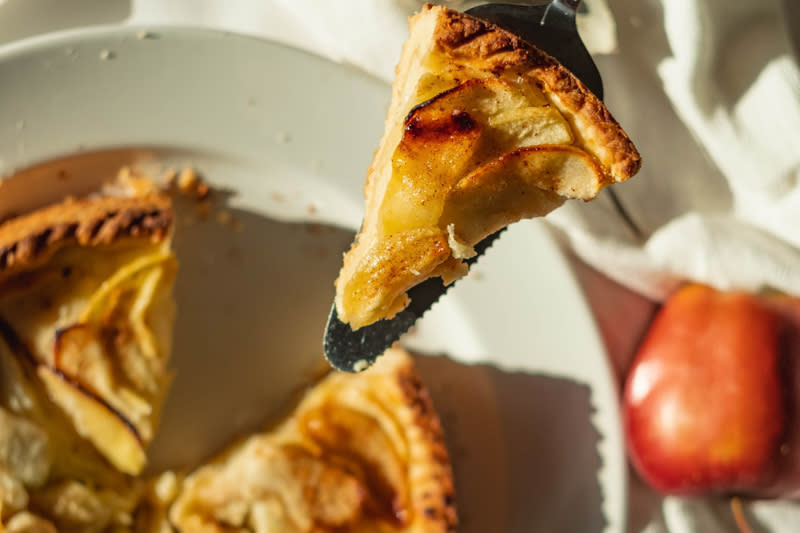
1. Ambrosia
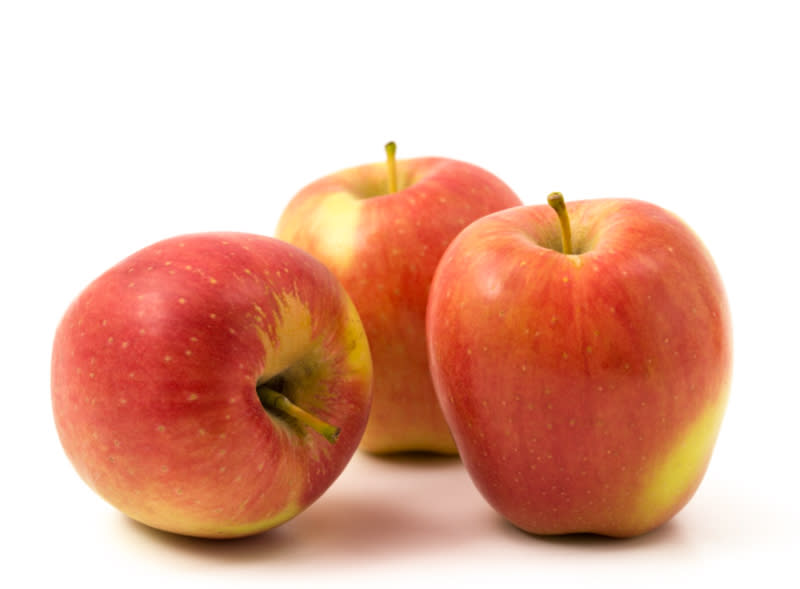
What it is:
Originating in British Columbia in the 1990s, the Ambrosia apple was a chance seedling in an orchard. These apples flower in mid to late season, and are mostly cream to buttery yellow colored with red patches.
What makes it unique:
Ambrosia apples have firm flesh and are on the sweeter and less acidic side of flavours. They have a slightly honeyed taste, reminiscent of pears. Since they are toned down in tartness, they can taste pretty one-dimensional. It’s good to eat them straight after chilling in the fridge, because its crispness fades quickly when left in the open.
Health benefits wise, they are a great source of both soluble and insoluble fibre, which can aid in digestion and lowering cholesterol. A low-calorie snack, they are also good for the skin, owing to the Vitamin A and C they contain.
What it’s used in:
With a slight one-dimensional profile, it is versatile and can compliment both sweet and savory dishes. It adds sweetness and moisture to desserts like cake, doughnuts, and muffins. When cooked, they tend to still hold in shape and flavour, thus they are great condiments of pies and tarts.
Price: From S$5.50 per pack (imported from US)
2. Cameo
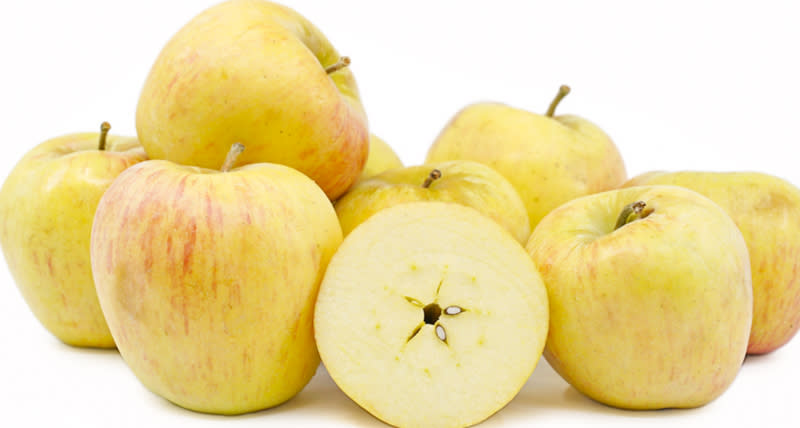
What it is:
Not to be confused with cameo paint, the Cameo apple is the more delicious one of the two. Formerly known as Carousel, it was discovered in the 1980s growing as a chance seedling in an orchard in Washington. Today, most of the commercially grown cameo apples are found there as well, and are available late fall through early spring. Cameo apples are creamy-white to yellow with some red streaks, and is a cross between the Red and the Yellow Delicious apples.
What makes it unique:
It has thin and delicate skin, with dense flesh that is juicy, sweet and balanced with a tinge of tartness. You can take crisp bites out of the apple and enjoy it as a snack, even so since they are sodium and cholesterol-free, and rich in soluble fibre.
What it’s used in:
They are used in both sweet and savoury applications. Since they are resistant to browning, they are often preferred for use in fresh preparations, like sandwiches, salads, and on cheese boards. Cameo apples also pair well with bacon and cheeses like goat, cheddar, and ricotta.
Price: Currently unavailable as it’s not in season
3. Empire
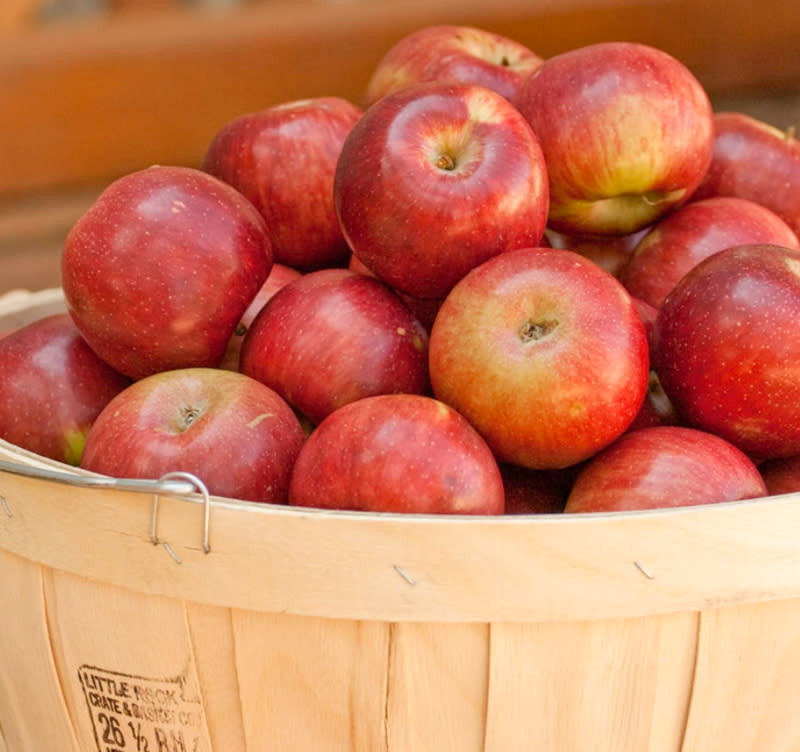
What it is:
The Empire apple is a cross between the McIntosh and Red Delicious apples, developed by researchers at the New York State Agricultural Experiment Station in 1966. They ripen in September and October and lasts until January. Empire apples are generally round, bright red with tinges of green.
What makes it unique:
It has a creamy white interior, with thick and firm flesh. Crunchy and juicy, it leans more on the tart than the sugary sweet side. Since it doesn’t bruise easily, it’s a popular lunch-box apple for children. The Empire apple contains Vitamins A and C, and is a great source of both soluble and insoluble fiber.
What it’s used in:
The Empire apple is firmer than its parent apple, the McIntosh, and makes for a good cooking apple. They are excellent on its own and in salads, and are common for making sauces and baking, especially pies.
Price: Currently unavailable as it’s not in season
4. Envy
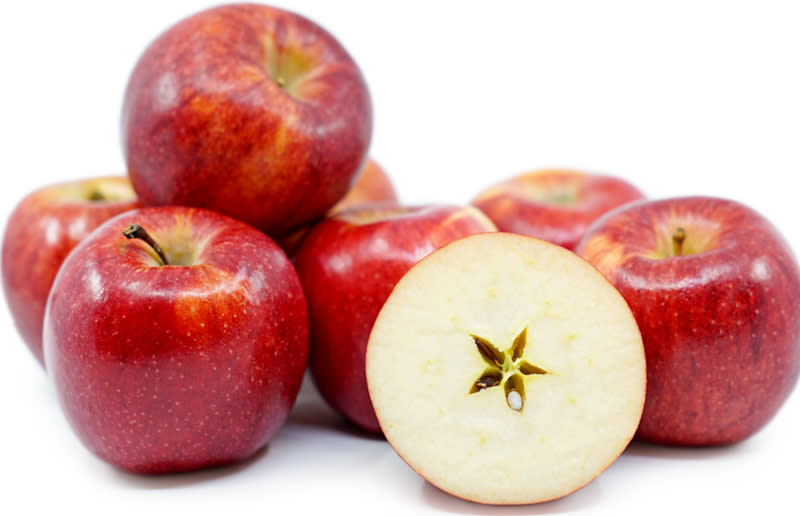
What it is:
The Envy apple has gorgeous ruby red skin that fills us with envy indeed. Round and red with yellow specks, Envy is actually a trademarked brand of the Scilate apple variety—a cross between the Royal Gala and Braeburn apple. It is grown using the Integrated Fruit Production (IFP) method, which takes environmental concerns into account during apple growing.
What makes it unique:
Its peel is thick and tough, so you’ll get a good, crisp crunch when you take a bite. Its sweet white flesh stays white for around 10 hours before turning brown. The Envy apple is low-calorie, with less than a 100 in a medium-sized apple. It’s high in dietary fiber and Vitamin C, with small amounts of quercetin, boron, and vitamin B.
What it’s used in:
Since it browns at a relatively slower rate than other apple varieties, it’s a good sliced snack. Its sweetness lends well to baking cakes and pies. They can also be diced and mixed into chicken and pork stuffing.
Price: S$5.95 per pack
5. Fuji
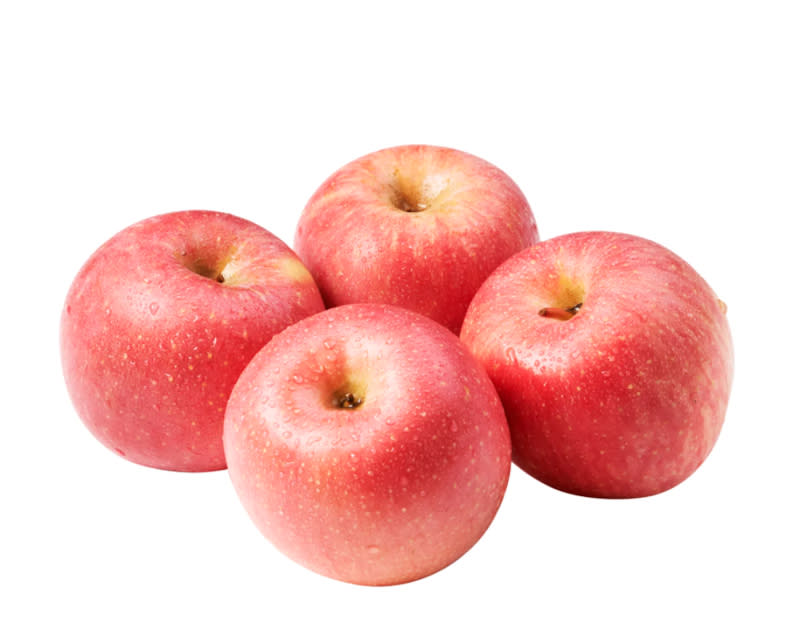
What it is:
Found in every supermarket here, Fuji apples are by no means unique to and in Singapore. These apples got their namesake from their hometown in Fujisaki, Japan, in a branch of the Tohoku Research Station, where they were created by Japanese growers. Fuji apples are available year-round, with a peak season in the late fall through winter. It is a relative of the Red Delicious apple, and is round and slightly lopsided, while known to display a wide range of skin color variation. Fuji apples are usually covered in red-pink striping and have a yellow base.
What makes it unique:
Its semi-thick skin is smooth and waxy, with dense and crisp flesh. It’s sweet and low in acidity, thus having a mild and balanced flavor with notes of honey and citrus. Fuji apples are an excellent source of vitamin C and fibre.
What it’s used in:
It’s used in both fresh and cooked applications like baking, roasting, and stewing. It can be added to salads and slaws without losing its consistency. With thick skin and dense flesh that stays well when cooked, it’s often used in soups and baked into pies, cakes, tarts, muffins, and crumbles.
Price: From S$4.25 per pack
6. Gala
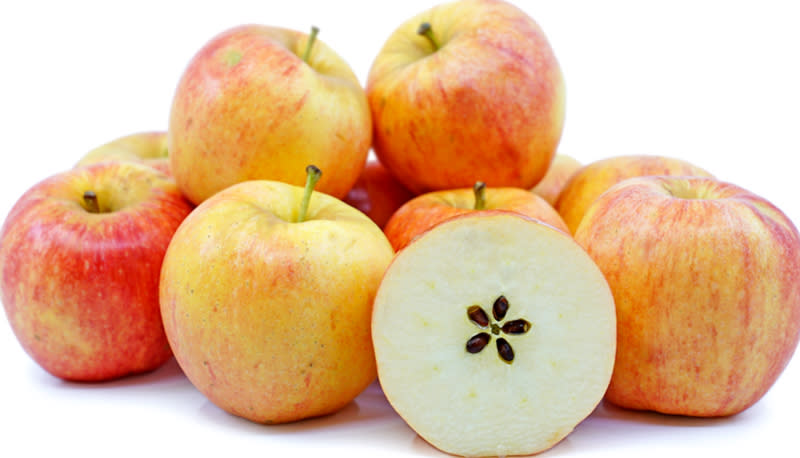
What it is:
The Gala apple is one of the most extensively grown apples in the world, parent to several varieties like the Jazz, Royal Gala (common in Singapore), and Pacific Rose apples. Grown in both the southern and northern hemisphere, Gala apples are available year-round. It’s taller than its width, with a similar shape to the Golden and Red Delicious apples. It is relatively small, with lighter red hues and bright-yellow undertones, and its hue varies depending upon the apples’ maturity.
What makes it unique:
It has thin skin, with a creamy yellow and dense flesh that offers a crisp in every bite. Together with its sweet flavour and floral aroma, Gala apples are easy to eat. They are low in calories, high in water content and contain a fair amount of Vitamins A, C and B. They also contain a dietary fibre known as pectin, which may lower cholesterol levels and help prevent heart attacks.
What it’s used in:
Popular in fresh applications, Gala apples are usually used in green, fruit, and chopped salads. Often used in baking, their sweet flavour becomes milder while cooking, thus they are often paired with stronger flavoured ingredients.
Price: From S$4.35 per pack
7. Granny Smith

What it is:
You can’t miss the Granny Smith apples in your go-to supermarkets, sitting along the fruit aisle in their bright green coats. These apples were discovered in the late 19th century growing naturally in Australia, as a chance seedling. They are one of the first apple varieties exported globally for sale in supermarkets, preferred for their long shelf life and thick, transportable skin. They are available year-round, with their peak season in October and November.
What makes it unique:
Beneath its brimming green exterior lies a dense and crisp white flesh that’s mildly aqueous. It has high acidity, bearing very tart and tangy undertones. It is also a great source of Vitamin C.
What it’s used in:
Firm and tough, Granny Smith apples are a versatile kitchen ingredient. Imbued with mildly sweet and acidic flavours, they can be used in both fresh and cooked applications like baking and roasting. They are used in cakes, cobblers, and pies, as the flesh holds its shape when cooked and does not discolor rapidly. On the savoury side, they complement onions and cheese.
Price: From S$3.50 per pack
8. Honeycrisp

What it is:
The Honeycrisp apple is the official state fruit of Minnesota, the most commonly grown apple variety there. Spotting high demands in autumn, this apple has skin that is blush red with undertones of green.
What makes it unique:
It carries a creamy white flesh that’s very crisp and aromatic. The balanced content of sweetness and acidity explains the sweet and tart flavour which varies in strength according to its maturity. Honeycrisp apples are high in dietary fibre, specifically pectin. They also contain Vitamins A and C.
What it’s used in:
Usually baked into pies, Honeycrisp apples maintain their sweetness while being cooked. They can be slow-cooked to make apple sauce and butter. Also, owing to their crisp texture, they are useful condiments in coleslaw, chopped salads, and burgers.
Price: Currently unavailable as it’s not in season
9. Jazz

What it is:
The Jazz apple was first developed in the mid 1980s in New Zealand, and commercial production started in the late 1990s. It is round with a rosy red skin, sometimes with undertones of yellow, orange and green.
What makes it unique:
The creamy yellow flesh of Jazz apples is extremely crisp and dense in texture. Embodying an intense sweet flavour, they lean more towards the fruity than acidic side with hints of pear. Their firm texture also makes them resistant to bruising. Jazz apples are high in antioxidants, folic acid, and the dietary fibre pectin, and the latter two may help in healthy heart functioning.
What it’s used in:
Jazz apples make for delicious desserts, like pies and tarts. Their sweet flavour and crisp texture holds well when they are baked, thus are frequent inclusions in bread, cake, and muffins.
Price: From S$5.50 per pack
10. McIntosh

What it is:
Yes, the Macintosh line of personal computers is named after the McIntosh apple. I could go on about these apple puns, but due attention has to be given to this national apple of Canada. In the 20th century, it peaked in popularity in Eastern Canada and New England. The McIntosh apple is all-purpose, favoured for both eating raw and cooking. Ripening in late September, it is painted in vivid red with bright green streaks.
What makes it unique:
The McIntosh apple has white and crisp flesh, with mild, sweet and tart flavours. It’s also exceptionally juicy, due to its high water content. This low-calorie snack offers a fair amount of vitamins A, C and B, as well as a dietary fibre—pectin, known for lowering cholesterol levels.
What it’s used in:
As it’s less firm than other apple varieties, it’s best suited to be eaten raw and chopped up into a salad or slaw, and atop pizza slices. Since their flesh breaks down easily when cooked, they are great as stuffing, puree or an addition to soup.
Price: Currently unavailable as it’s not in season
11. Pacific Rose
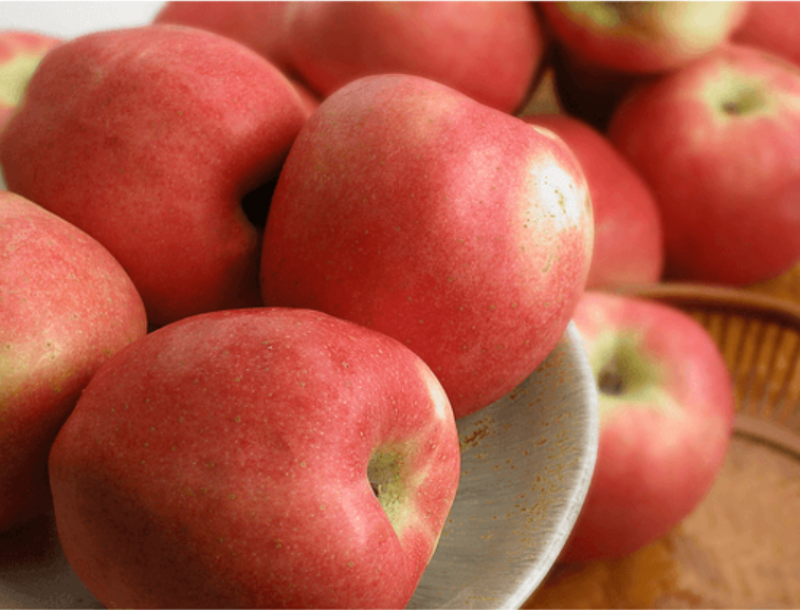
What it is:
With a namesake that sounds as beautiful as it looks, the Pacific Rose apple is a cross of the Gala and Splendour apples. They get their signature pink colour from the latter. The name of these large apples carry literal meanings, as they were surrounded by the Pacific Ocean and are rosy in complexion.
What makes it unique:
Beneath its rosy hue lies a yellow flesh with a coarse texture. It is juicy but mild with a less tart and sweeter flavour.
What it’s used in:
These apples are best eaten fresh out of hand, but their sweetness makes them a good addition to green, fruit and cottage cheese salads, sandwiches, and desserts.
Price: From S$8.60 per pack
12. Pink Lady

What it is:
Embodying the trend towards product branding in the sale of apples, Pink Lady was one of the first apples to be marketed under a specific brand name, rather than by its variety name. Originally named Cripps Pink, first bred by crossing the Australian apple Lady Williams with a Golden Delicious apple. Like its moniker, it is coated with a pink to reddish-pink blush with yellow tones beneath, and is available from late fall into spring.
What makes it unique:
It has an initial tart taste with a sweet finish, and a crisp and slightly dry flesh that is creamy white. Pink Lady brand apples must meet certain trademark quality specifications, like for sugar content, firmness, blemishes and colour. Its substandard counterpart is called Cripps, the apples that fail to meet sugar, acid, and firmness levels.
What it’s used in:
Its crispness and tangy tastes make them appetising as a snack and a good baking and cooking ingredient, in apple sauce and pureed soups.
Price: From S$6.17 per pack
13. Red Delicious
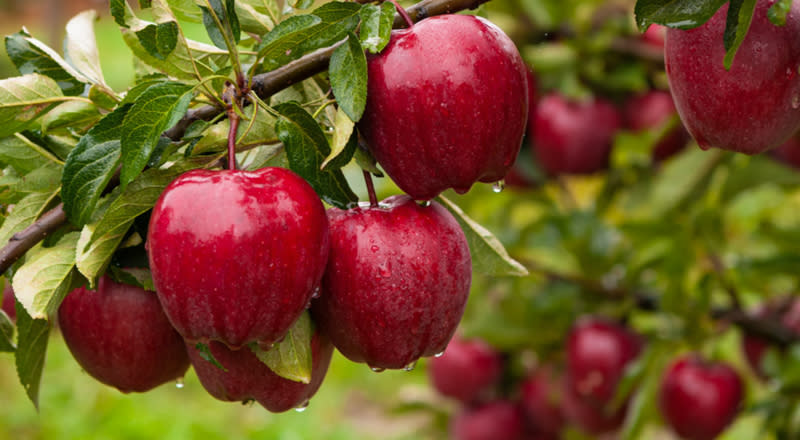
What it is:
The Red Delicious apple has a name that’s as literal as it gets. These delectable apples turn bright red right before fully ripened, and darken with maturity. The Red Delicious apple is the most popular apple variety in the U.S, and is the parent apple of several popular varieties like Empire and Fuji apples. They are exported to many countries around the world, and are available year-round with a peak season in the early fall.
What makes it unique:
Their fine-grained flesh is creamy-white and they are crisp and juicy. Imbued with a sweet taste, their flavours resemble a tad of melons’. Over a century, improvements to the apple’s shape, firmness, juiciness and colour has caused it to look very different from its first discovery. It is high in dietary fibre and contains Vitamin C while being higher in antioxidants than many other apple varieties.
What it’s used in:
Since their flesh disintegrates quite easily when cooked, they are best used in fresh preparations like salads, and can be slow-cooked and pureed into sauces and soups. They are also popular as an edible garnish on sandwiches, quesadillas, and burgers.
Price: From S$3.95 per pack
Other articles you might like:
Produce explained: 7 common stone fruits you ought to know
Produce explained: 7 essential root vegetables you need in your kitchen
The post Produce explained: 13 types of apples to have in your pantry appeared first on SETHLUI.com.


